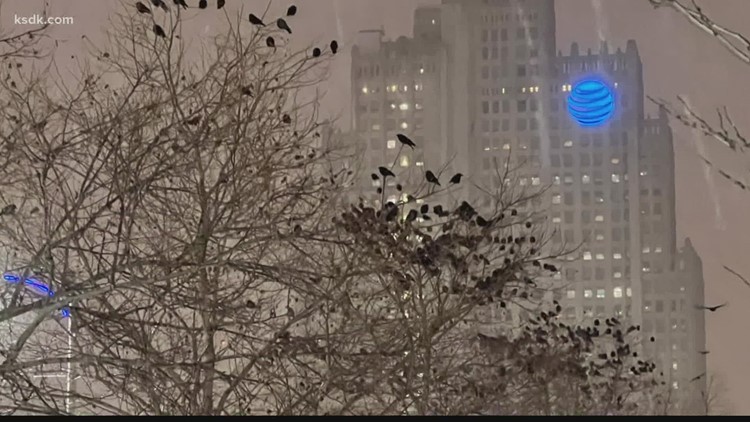ST. LOUIS — Contemplation and quiet introspection usually color walks in Downtown St. Louis at dusk. The lights of the city's skyscrapers, the wind blowing through the leaves of the trees, and the steadily flowing river give people pause to reflect on past years and look forward to moments still to come.
The often silent stillness is shattered once the first cold breeze of winter drifts through the city's streets, interrupted by the caws of countless crows.
The city's skies often resemble a scene straight out of Alfred Hitchcock's "The Birds" during the colder months, with the crows flying between perching on downtown trees or up on the edge of buildings, looking down on passersby.
This is what a common winter evening outside the 5 On Your Side news station looks like:
Some Downtown residents may see the birds' yearly return as a temporary nuisance. In reality, it's less of a vacation outing, and more of a homecoming for the birds.
"Crows are super territorial and they tend to want to come back to the same places," according to Erin Shank, community and private lands regional supervisor with the Missouri Department of Conservation. "They come back to where they're familiar, and that just happens to be downtown and outside the federal courthouse."
Shank was one of the officials responsible for investigating why numerous crows were dying Downtown in 2022, and during that time she got to know the intricacies and history of the birds, including why they moved from rural to urban areas over the past few centuries.
Crows used to be known for damaging farmers' crops, but the birds have steadily moved from farms into cities. Shank said that's mainly to stay warm.
"Cities' warmer heat-island effect through the winter makes it less stressful for crows because they don't have to maintain their body heat as vigorously," Shank said. "The abundance of scavenging opportunities in urban areas helps as well, along with fewer predators."
St. Louis' skies used to be even more filled with crows before the birds faced their own pandemic in the early 2000s. A strain of West Nile Virus decimated the national crow population, killing around 65% to 70%, Shank said. The population just recently started to bounce back, giving people the perception of above-average amounts of crows.
"Crows had around a 100% mortality to West Nile early on when it was spreading so rapidly," Strain said. "Now, their populations have returned to normal over the last five to seven years. But, because they're long-lived, and they really don't breed until they're 7 years old, that kind of a hit to a population can just take time to recover."



